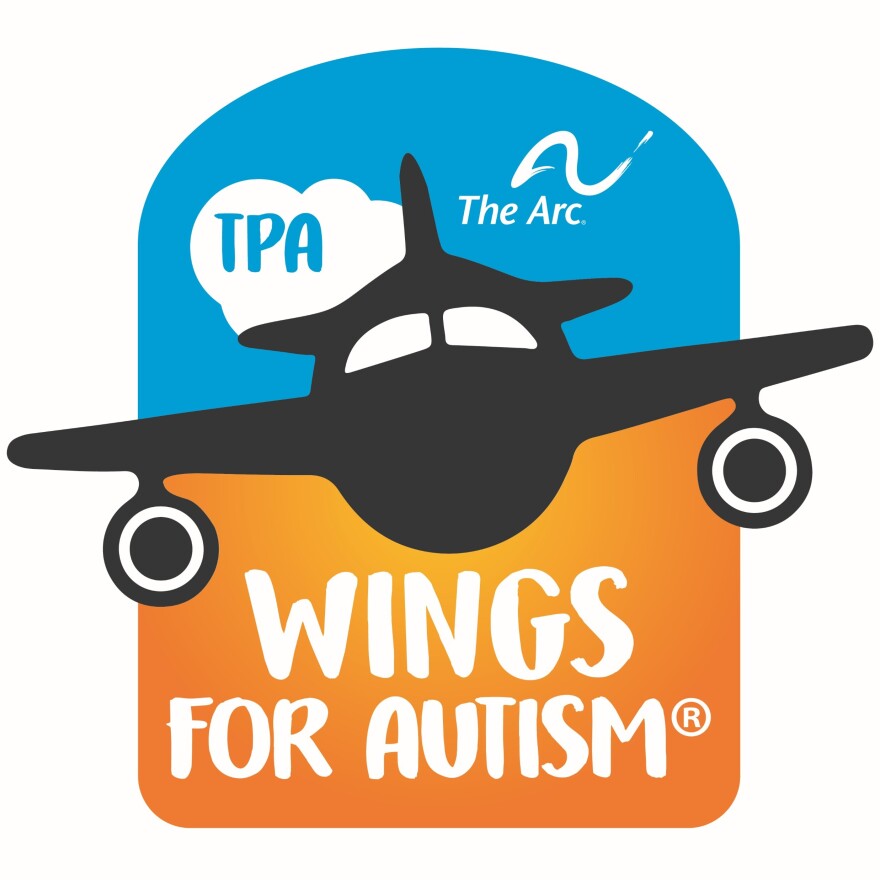If you have a child with autism, chances are they don’t just have autism spectrum disorder, they also have another condition that makes it harder for them to make their way through experiences that are a cakewalk for others.
And when it comes to travel, the unpredictability of making your way through the airport and flying can be overwhelming. From the hassle of moving through security to taking off.
Now imagine all those experiences amplified.
The lines can become more stifling. The transitions from security to the plane can be more confusing. And the chatter of people inside can be like a blasting boombox.
These types of sensory challenges may be a standard part of life for some people with autism. The buzzing lights, or unexpected sounds and events can heighten anxiety or become downright painful.
And according to the executive director of The Arc Tampa Bay Foundation, Beth Tasis, these challenges can make the airport experience more daunting.

"I think we all know that airports can be incredibly overwhelming for everybody. There's a lot of stimuli when you're walking through any airport, but certainly for a child with autism, the sensory overload and that unfamiliar routine can really make air travel challenging," Tasis said.
That's why the foundation is partnering with Tampa International Airport and Southwest Airlines to make air travel a little less intimidating for children with autism and their families.
It’s called Wings for Autism, and Tasis said this is the first time her local organization is offering it.
“So the way that it came to be is a gentleman who has a young child with autism was talking with his wife about how they could possibly engage in taking their typical family vacation, which they were really excited about, the prospect of doing that, but really had some apprehension about how their child ... would handle that whole transition process of going through the airport and taking the trip,” she said.
Tasis said The Arc of the United States paved the way with Tampa International and Southwest, which is allowing the use of its plane. This first “practice run" took place Saturday.
The children and their families go through security, the boarding gate and get onto a plane. This helps them know and understand what the experience is like. And that means when they take a real plane trip, it won't be so mysterious and frightening.
Sample social story
There are some things you can do to ease the way for your child to fly if it’s their first time, Tasis said.
It starts with something "known as a social story, which is creating a very step-specific story of the experience that they're going to encounter, from checking in the bags to getting the ticket, going through security,” Tasis said.
The details are important, and so are the pictures. Here’s a sample social story you can customize to help your child with autism get a sense of what to expect at the airport:
Next month, we’re going to the airport to take a plane trip to visit Grandma in Ohio.
When we get to the airport, we have to go through security to keep everyone safe. We will need to put our keys and phones, and bags and jackets if we have them, on a belt to go through a scanner.
And we’ll need to walk through a special doorway. Someone may use a wand to pass over your arms. You may hear some beeps and other noises if someone goes through the special doorway with their keys in their pockets.

Once we pass through security, we will make sure we have all our bags and then take a little train to the terminal where the plane is parked.
We may have to wait to get onto the plane. While we’re waiting, we can get a snack or you can use your iPad or listen to music. When it’s time, we will get into line and a nice person will scan our tickets or the boarding passes on our phones, and then we will walk through a carpeted tunnel to get onto the plane. The plane may have some smells or sounds you’re not used to, so be ready for that.
The flight attendants will say, “Hello!” when we get onto the plane, then we will take our bags and walk to where our seats are. The seat numbers will be on our tickets or electronic boarding passes. We will put our luggage under the seat in front of us, or in the overhead bins and then sit down and buckle up. We’re ready to go!
Once the plane lands, we’ll have to wait for the seat belt light to go off and hear the “ding,” and then we can unbuckle. But it may take some time before we can get off the plane. While we’re waiting, you can play games on your phone or listen to music, and once it’s our turn, we can grab our bags and get off the plane and head to Grandma’s. Great job flying, Buddy!
Other tips to help
Tasis said another way to help a first-time flyer with autism get comfortable after going over their personalized social story with them is to role-play.
“You can practice going through security by using a backpack, actually pretending to walk through a scanner, so when the time comes, it feels a little bit more familiar and helps to kind of ease some of that anxiety of going through that experience for the first time,” she said.
Tasis said be sure to take advantage of TSA Cares for people with autism or with intellectual disabilities.
"TSA Cares, which will support families who, with 72 hours' notice, if you call ahead, you can request special assistance, so they can give you a little bit more time to gracefully get through security without having to feel so rushed," Tasis said.
She also said to use preboarding, which will give you a little extra time to make that transition from being at the gate to getting on the plane.
And make sure when you’re packing that your child brings a favorite blanket or stuffed animal in a carry-on bag. If you forget those at home, that could put the brakes on a trip before you ever get to the airport.




